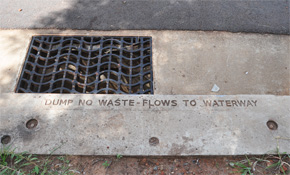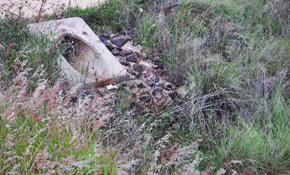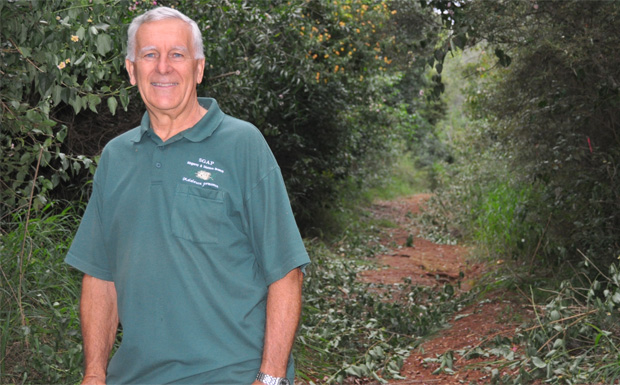
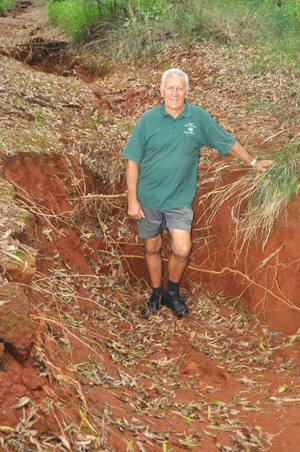
March 29, 2013
“It’s our heritage and we have virtually nothing left … we should either protect it or just give up and put a highway through it.”
These are the words of Society for Growing Australian Plants (SGAP) member Graham Helmhold talking about Tessmanns Road North in Kingaroy.
Of course, he’s not serious about the highway. He’s spent hours trying to protect this precious piece of remnant vegetation, removing lantana, mapping native plants and shooing away trailbike riders.
But he’s concerned that his efforts to protect some of Australia’s most endangered native plants are being frustrated by neglect.
SGAP members say that more than 10 per cent of a critically endangered plant, Phebalium distans (also known as Mt Berryman Phebalium) have been allowed to die through uncontrolled stormwater run-off or have been removed through clearing or roadworks.
“Critically endangered means the next step in extinction!” an SGAP member told southburnett.com.au
Phebalium distans is a small tree which can grow up to 8m tall with a trunk up to 15cm in diameter.
It’s extremely slow-growing, has never been grown from seed, and there is no record of “vegetative reproduction”, ie artificial propagation.
On April 21, 2006, the Kingaroy Landcare group counted 250 Phebalium distans (mature and juvenile) along Tessmanns Road North.
A follow-up survey was conducted in 2009-2010 for the South Burnett Regional Council and found exactly the same number, ie there had been no loss of population in about four years.
The botanist who completed the survey said the position of every tree at that time was provided to council and logged in a database.
However since then the Phebalium have been dying and disappearing and SGAP members say they have not been able to stir the South Burnett Regional Council into action.
Tessmanns Road North is temporarily closed to traffic to protect the Phebalium but it is still a gazetted road reserve rather than a conservation area.
And because it is a road reserve, Council has a responsibility to maintain access to farm gates located along its northern end (although SGAP says only one house is located in this area.)
The road was re-formed in 2008 and then refurbished again last year.
SGAP believes this second refurbishment led to the death of six Phebalium marked on the council database. Members can only find a trace of one left, a stump. They believe the rest of this tree may have been taken away and mulched.
But the roadwork at the northern end of the road – and some fenceline clearing in the same area – are only some of the problems the Phebalium are facing.
The southern end of the road has suffered severe erosion with culverts greater than a metre deep in many places and topsoil stripped away.
Graham says excessive stormwater coming off the adjacent housing estate has been eroding the roadway, depositing silt on a bend of the road where Phebalium distans was growing.
The Phebalium in this area – dubbed the “wet corner” by SGAP – were stressed by the changed conditions and wet soil which made them vulnerable to insect attack. All the plants that had been recorded in this area have now died, to be replaced by lantana.
There are scattered populations of Phebalium distans elsewhere in Queensland but the total population size has been estimated to be 1000 plants, of which only 175 are mature individuals. Many of these occur along the Tessmanns Road North road reserve which is why the loss of even a single plant is critical.
SGAP says it has approached the South Burnett Council on numerous occasions to fix the stormwater problem; and although mitigation works had been promised, the erosion is still occurring.
Members say this is one of the most important environmental sites in the South Burnett region and should be a priority for council biodiversity funding.
“Tessmanns Road North is a unique place in the South Burnett that is publicly accessible,” Graham said.
There are eucalypts on top and dry vine scrub on the escarpment.
This transition from dry rainforest to tall, open sclerophyll forest is rare in a public area.
While we were there, there were whipbirds calling and tree creepers flitting about. A koala has been spotted nearby in the past.
SGAP wants the stormwater diverted away from the road and the erosion repaired … carefully, and without introducing any more weed plants into the space.
Then the area could be left as a walking track for local residents and the Phebalium left in peace to slowly start rebuilding its population.
“This is a unique public space,” Graham said. “If we can’t protect this we can’t protect anything.”
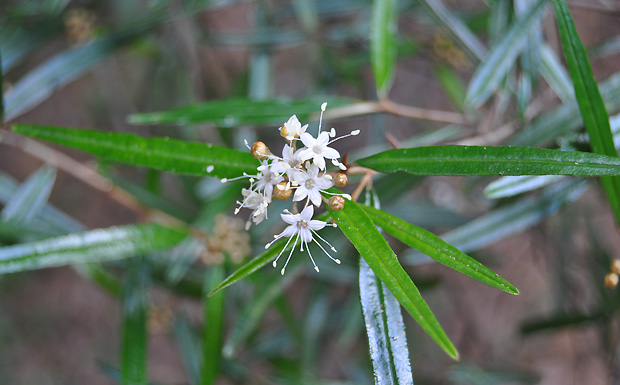
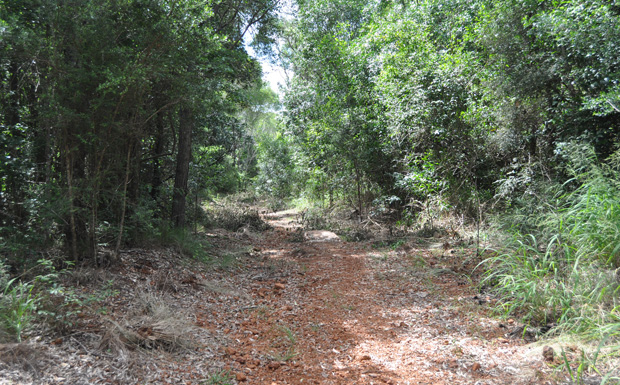
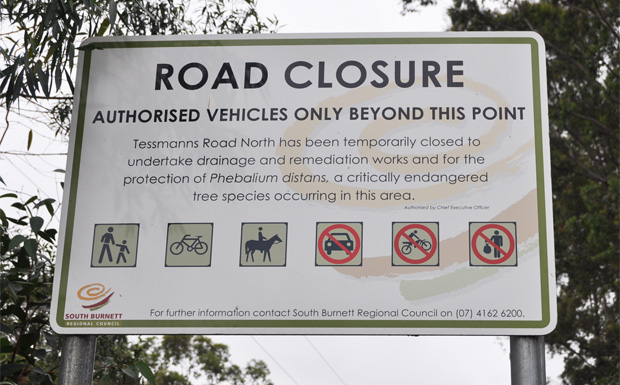

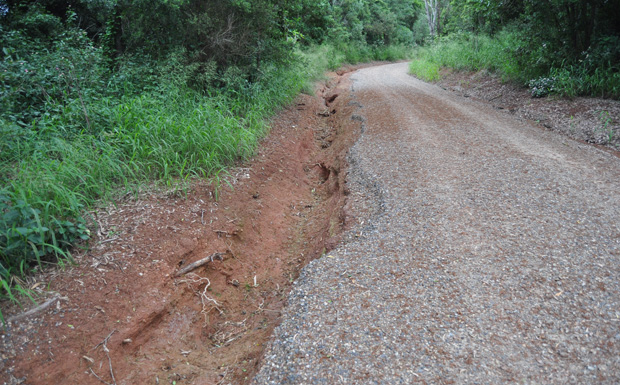
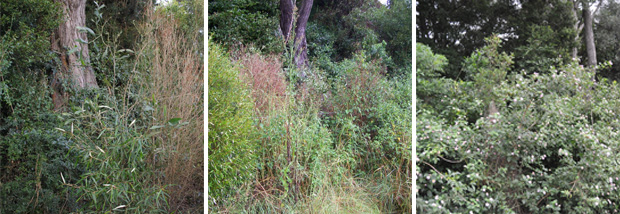
“The main threats to Mt Berryman Phebalium are vegetation clearance, ‘cleaning and tidying up’ of scrub, inappropriate fire regimes, urban development and damage to plants through roadworks and roadside maintenance. Many of the vegetation remnants where this species occurs are too small to be mapped and protected under the Queensland Vegetation Management Act 1999. As a result, utilities infrastructure development and maintenance (including roads, telephone and electricity) may pose a significant threat to this species.
As Mt Berryman Phebalium does not resprout or germinate following fire, inappropriate fire regimes have the potential to lead to localised pressure following fire events.
The largest population of Mt Berryman Phebalium is threatened by increasing urbanisation and associated infrastructure development in the Tessmanns Road area in the South Burnett region. If Tessmanns Road were to be sealed, surrounding vegetation would have to be removed, including Mt Berryman Phebalium plants.
Potential threats to this species include drift of agricultural chemicals, erosion, soil compaction from human traffic, rubbish dumping, inappropriate habitat modification and invasion by weeds such as Guinea Grass (Megathyrsus maximus) and Climbing Asparagus (Protasparagus africanus). Invasive weeds also increase the fuel load of the area and can make Mt Berryman Phebalium more susceptible to damage from fire.”







